The Dusey

Beez Neez now Chy Whella
Big Bear and Pepe Millard
Sun 24 Aug 2014 22:47
|
The
Duesenberg
 The beautifully restored Duesenberg.
One of
the stunners at Warbirds and Wheels, a real wow of sheen and class. According to
Duesenberg records this car was sold new to Hollywood star Carole Lombard in 1934. It
carries the La Baron ‘sweep panel’ dual-cowl sports phaeton body. One of nine
made. The La Baron has been described as the “quintessential Duesenberg” design.
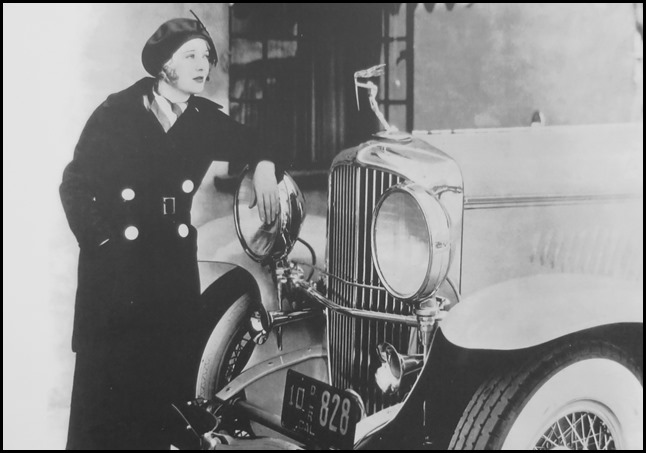 Carole Lombard
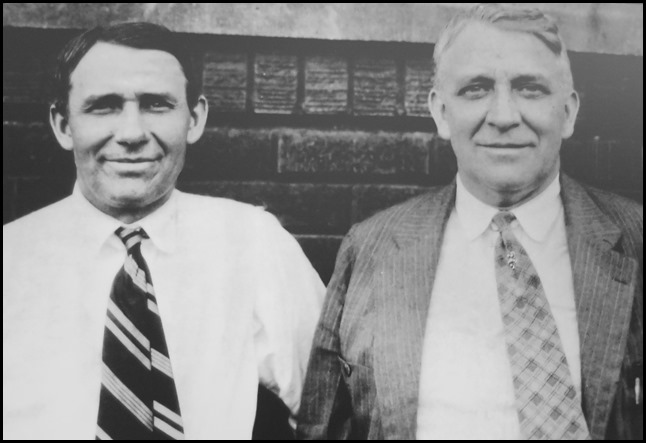 The Duesenberg story is a story of two immigrant brothers and a
dream to build the finest automobile in the world. Frederick
and August Duesenberg were born in Lippe, Germany and immigrated to the
United States in 1884 with their widowed
mother and four older brothers and sisters.
The
brothers were raised on a farm in Rockford, Iowa. A few years after leaving school the pair teamed up to open a bicycle shop but
it wasn’t long before they moved into the automotive business. In 1906, the
brothers received financial backing from lawyer Edward R. Mason and they began
building a lightweight two-cylinder Mason automobile.
In 1909 the company was bought by
Senator Frederick Louis Maytag but the relationship was shortlived and in 1911
Maytag decided his future lay in washing machines not cars. By 1913 Fred and
Augie had moved to St Paul, Minnesota and established the Duesenberg Motor
Company specialising in racing car and powered boat engines.
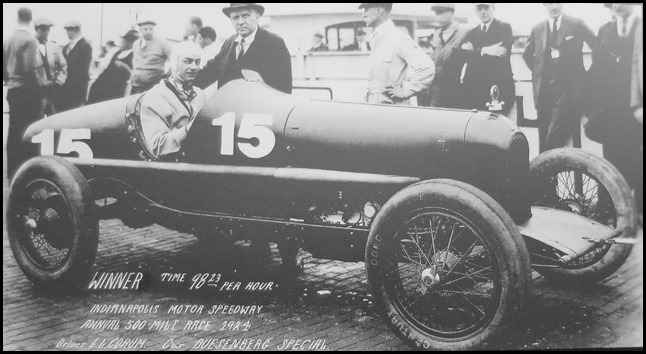 America’s first supercharged racing
car wins the 1924 Indy 500.
The Duesenberg name started to be
noticed when Eddie Rickenbacker the famed World War One fighter ace, drove a
Duesenberg to place finish in the 1914 Indianapolis 500. Duesenbergs would go on to win the ‘Indy 500’ in 1924,1925 and 1927.
The brand gained international recognition when American Jimmy Murphy drove a
Duesenberg to win the French Grand Prix.
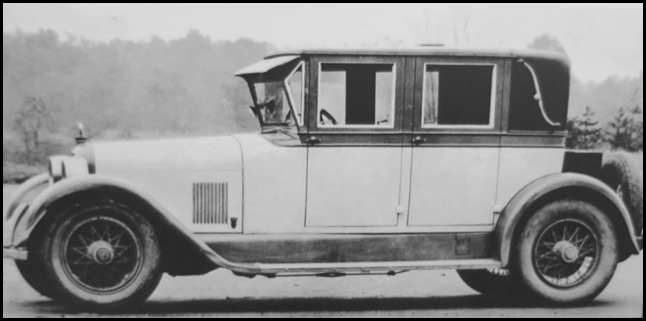 Following World War One the brothers
moved to Indianapolis and work on their own production cars. The result was
the Duesenberg Model A debuted at the New York Auto
Show in 1920. The Model A did not sell as well as had been hoped and the
Duesenberg Company began to struggle.
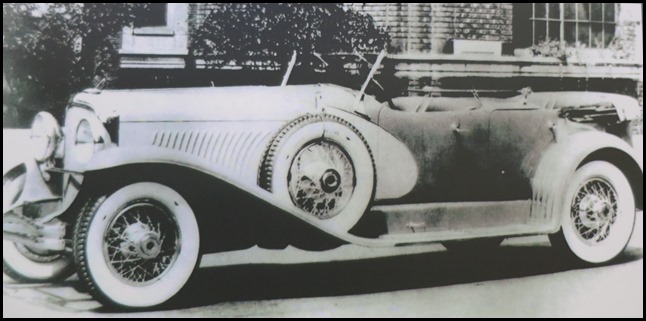 It was then bought by Errett Lobban
Cord in 1926. Cord was producing motor cars under the Auburn brand. Fred stayed
on while Augie left to run a separate Duesenberg car producing company. E.L.
Cord gave free reign to produce “the greatest automobile ever built in the
United States”. In less than two years Fred came up with the
Duesenberg Model J. The car was based around a powerful eight cylinder
motor producing two hundred and sixty five horsepower. In the mid 1930’s
Duesenberg brought out a super charged version giving three hundred and twenty
five horsepower and top speeds reaching one hundred and forty miles per hour.
Its nearest rivals at the time, the V16 Cadillac and V12 Packards put out one
hundred and seventy five horsepower.
Only the rich and powerful owned a
Duesenberg. Over the years owners have included Carole Lombard, Clark Gable, Al
Capone, Mae West, Howard Hughes, The Duke of Windsor, William Randolph Hearst
and King Alfonso XIII of Spain.
The Duesenberg Model J has been
described as the greatest car ever made in the United States. In the 1930’s it
was regarded as the fastest, most flamboyant and technically advanced motor
vehicle in the world. There was nothing quite like it and the Duesenberg J was
the first American car to head to head with the best European cars when it
came to luxury and engineering.
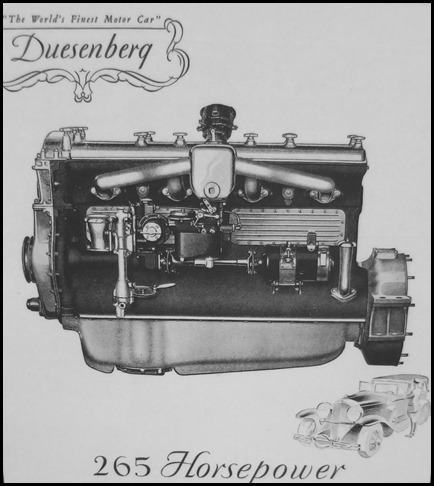 Advertising
for the Duesenberg pulled no punches.
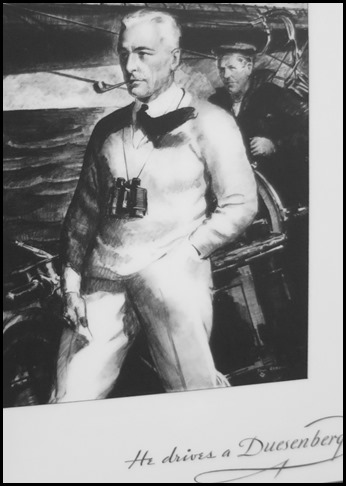 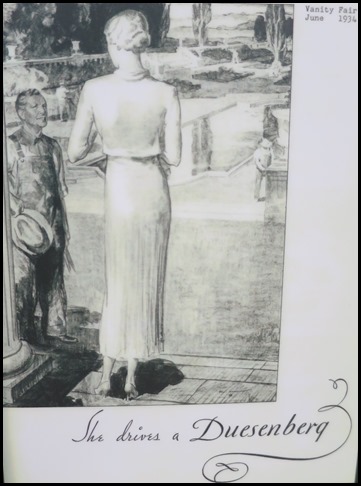 Advertisements described the Model J
as “The World’s Finest Motor Car”. They talked about a “new concept of motoring
that could not be obtained from any other car”. One series of advertisements did
not feature the car or anything about the vehicles, rather they depicted men and
women partaking in pursuits such as sailing, shooting
or going to the
theatre.
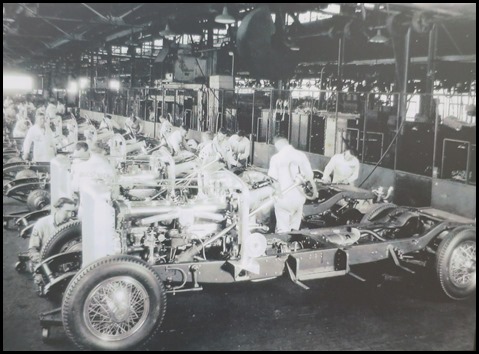 Over nine years a
total of four hundred and eighty one Duesenberg Model J motor vehicles were
produced. It is testament to the value and quality of these cars that
there are still some three hundred and seventy eight remaining in the world
today.
The Duesenberg J was released as a
running chassis only. The cost at the time for the chassis and motor was eight
thousand US dollars rising to nine thousand five hundred. by the end of 1936.
Customers then chose from a catalogue of coach
built body designs. There were forty different designs to choose from. The
bodies cost anywhere between thirteen and nineteen thousand US dollars, two of
the bodies reached twenty five thousand. To put this in perspective, at the
time, the Duesenberg J compared to three Packards or sixty Fords. The average
physician in America at the time was earning less than three thousand a
year.
Some owners purchased two bodies, one
for the summer – roadster or phaeton, and one for the winter – normally a four
door hard top sedan. The factory could change the body over in a matter of
hours. Some customers were drawn to the exquisite design and luxurious features
of the car, others were drawn to the sheer power of the car.
Unfortunately Fred did not live to
see all the Duesenbergs made. He was killed in 1932 while out road driving on a
wet Lincoln Highway in Pennsylvania. Shortly after Fred’s death Augie returned
to the company and continued to work there for the next five years. But by 1937
it was all over. The Auburn-Cord-Duesenberg company was closed and with it one
of the greatest chapters in the history of the American automotive
industry.
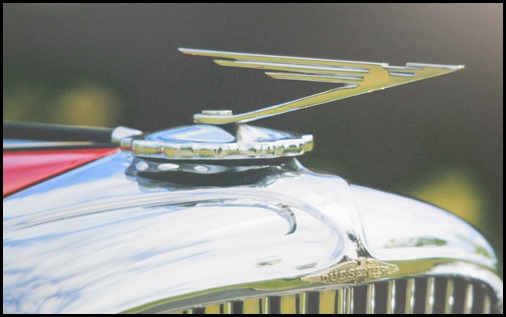 The
Duesenbird.
The famous ‘Duesenbird’ radiator
ornament was designed by Gordon Miller Buehrig who was an integral part of the
Duesenberg story. A young man going places fast. Gordon was appointed chief body
designer for Duesenberg at the age of twenty five. He became good friends with
both Fred and Augie and spent three years living at Fred’s home.
The art deco inspired ‘Duesenbird’ is
regarded as one of the all-time great designs of its kind.
After the collapse of Duesenberg
Gordon continued working as a designer for a number of companies including Ford.
In the late 1960’s he took a job as a tutor at the Art Centre College of Design.
Gordon was named one of the thirty most important men in the history of the
automotive industry by the Society of Automotive Historians. He was responsible
for some of the most enduring classic body designs to come out of the United
States.
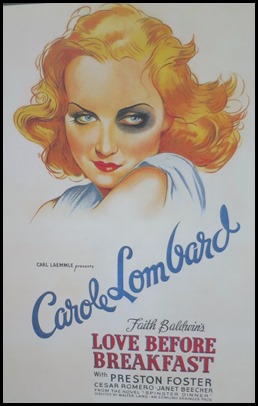 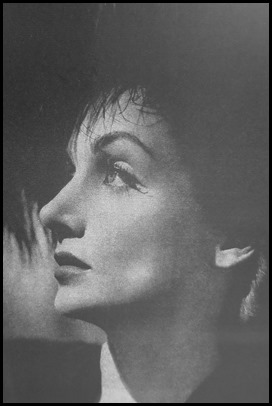 American actress Carole Lombard had
many claims to fame. Carole has been recognised by the American Film Institute
as one of the greatest stars of all time and was the highest-paid Hollywood star
in the late 1930’s. Carole made her film debut in 1921, at the age of twelve
when she was cast as a tomboy in A Perfect Crime. Her career really took off in
1934 when she starred in the film Twentieth Century. In 1936 she achieved an
Academy Award nomination for her role in My Man Godfrey. By the late 1930’s
Carole was earning around half a million dollars a year which at the time was
five times the salary as the President of the United States. It was this level
of income which allowed her to indulge in one of her passions – the purchase of
beautiful motor vehicles like the one at the top. After a failed marriage to
actor William Powell and her relationships with the likes of Gary Cooper, Carole
fell for Clark Gable, who was still married to oil heiress Ria Langham. At the
time MGM was trying to sign a reluctant Gable to play the role of Rhett Butler
in Gone With The Wind. The story goes that to sweeten the deal MGM boss Louis
B.Mayer agreed to pay the money required to settle a divorce agreement with
Langham.
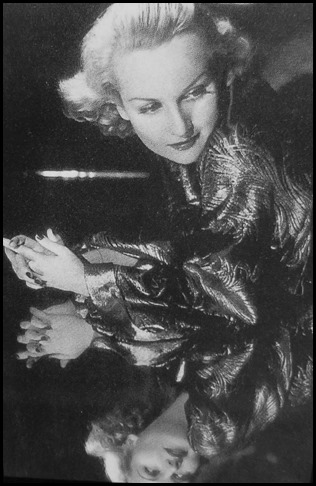 Carole Lombard
married Clark Gable on the 29th of March 1939 during a break in production of
Gone With The Wind. Both of them were huge fans of the Duesenberg. Not long
after the US entered WWII, Carole travelled to her home state of Indiana for a
war bond rally with her mother and Clark Gable’s press agent Otto Winkler.
Carole was able to raise more than two million dollars in defence bonds in a
single night. Tragically, on the 16th of January 1942, all three died when their
plane crashed on the return trip to Los Angeles.
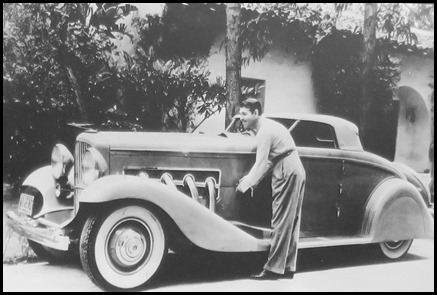 The cars are very valuable. In 2011 a
1931 Duesenberg Model J long-wheel base coupe sold at auction in the United
States for ten point three four million dollars putting it in the top five
highest prices ever paid for a motor vehicle. In 2012 a 1935
Duesenberg Model JN coupe owned by Clark Gable was put up for auction but
was passed in at six point four million dollars. The connection between the entertainment industry and Duesenberg
brand continues in the USA today with talk show host Jay Leno owning sixteen of
the cars.
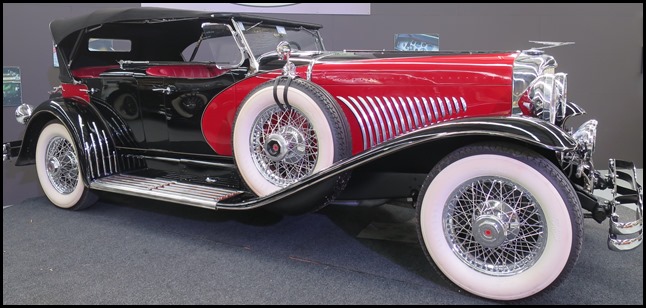 Restoration of the Duesenberg: This car arrived in Wanaka in 2011. It had been partly
restored in the United States by its former owner who had the car since the
early 1950’s. The vehicle has undergone a “body off” restoration in Wanaka which
was carried out in two parts. The body was removed and underwent panel, paint
and upholstery work while the chassis and motor was restored separately. The two
parts then finally came back together allowing the finishing work to take
place.
While the vehicle was in extremely
good condition when it arrived there were still some parts missing which had to
be fabricated locally. This included most of the windscreen frame, the wing
mirrors, the hood bows and irons along with the seat base and frames. The paint
finish is an original Duesenberg colour scheme of red and black.
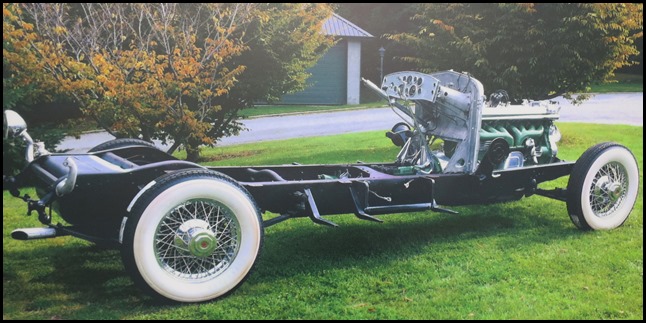 Once the body was removed work could
begin on the running chassis. This picture was taken about half way through the chassis restoration.
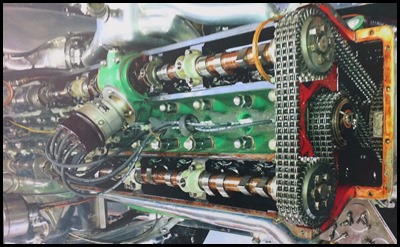 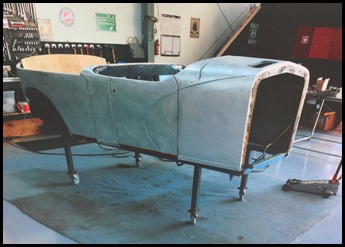 The motor was in good working order
but did need some adjustments. Here the cam settings
are being checked. The body
was stripped down to the bare metal by Lee and the team at Rodz and
Restos in Wanaka. Some features on the original bodywork had been filled with
lead to produce a smooth finish. The lead had to be melted before being removed
to restore the original look.
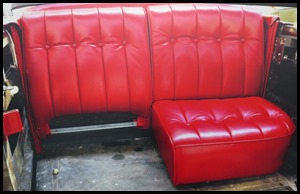 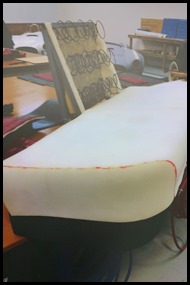 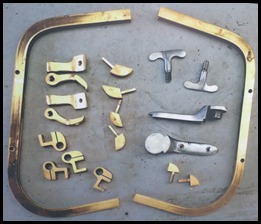 New seats had to
be made from scratch. The restorers were insistent on using springs in
the seats as per the original. The new upholstery was finished in high-grade red
Italian leather.The work was completed by Bevan Garland from Upholstery Alley.
Fabricated parts made by Barry Morgan of Performance
Engineering.
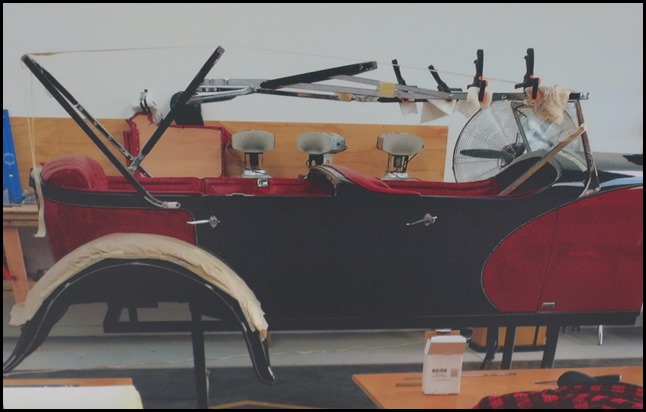 The stunning paint job was completed
and work started on setting the hood bows and irons.
All the woodwork was done by John Martin of Designs N Wood.
It’s a Dusey. Ever wondered where the
saying came from? The phrase was first coined in the late 1920’s and reflected
the awe with which the American public regarded the Duesenberg motor car. A
‘Dusey’ is seen as something excellent or extraordinary just like the
Duesenberg.
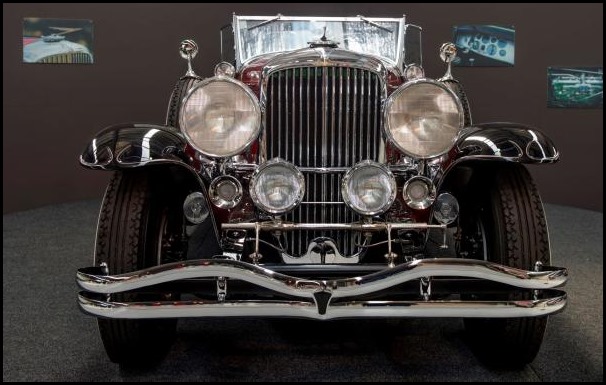 ALL IN ALL LOVELY CURVES AND VERY AL
CAPONESQUE
VERY IMPRESSIVE AND BEAUTIFULLY
RESTORED |